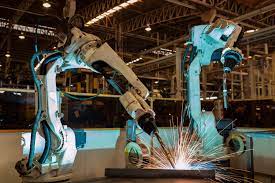How Robotics is Transforming the Construction Industry: An Overview
The construction industry has traditionally relied on manual labor and heavy machinery for construction and maintenance work. However, with the rise of robotics, the industry is now experiencing a revolutionary transformation. Robotic technology has the potential to improve construction processes by reducing labor costs, increasing productivity, and improving safety. In this article, we will take a closer look at how robotics is revolutionizing the construction industry.
Robotic Equipment for Construction
Robotic equipment has been developed for use in construction sites. These robots are designed to carry out tasks that would otherwise be carried out by manual labor, such as bricklaying, demolition, and excavation. One of the most popular robotic equipment used in construction is the bricklaying robot.
Bricklaying robots are designed to lay bricks faster and with greater accuracy than human labor. They use a combination of computer vision and algorithms to accurately place bricks in the right position. This not only reduces the amount of time taken to complete the task but also reduces the number of errors that occur during the bricklaying process.
Another example of robotic equipment used in construction is the demolition robot. Demolition robots are designed to safely demolish buildings and structures. These robots are equipped with advanced sensors and cameras that allow them to identify and avoid obstacles during the demolition process.
Excavation robots are also used in construction sites. These robots are designed to dig and move earth faster and more efficiently than manual labor. They are equipped with advanced sensors and cameras that allow them to accurately dig in the right place.
Robotic construction equipment has the potential to reduce the amount of time taken to complete construction projects. This, in turn, reduces labor costs and increases productivity. These robots are also able to carry out tasks in dangerous environments, such as demolition sites, which increases safety on construction sites.

Autonomous Construction Equipment
Autonomous construction equipment is another form of robotic technology that is transforming the construction industry. These autonomous machines are designed to carry out tasks without human intervention. They are equipped with advanced sensors and cameras that allow them to operate safely and efficiently.
Autonomous bulldozers and excavators are examples of autonomous construction equipment. These machines are equipped with sensors and cameras that allow them to navigate construction sites and carry out tasks without human intervention. They are also able to avoid obstacles and identify potential hazards on construction sites, which increases safety on construction sites.
The use of autonomous construction equipment has the potential to improve productivity on construction sites. These machines are able to operate 24/7, which reduces the amount of time taken to complete construction projects. They are also able to operate in dangerous environments, such as mines and quarries, which increases safety on construction sites.
3D Printing in Construction
3D printing technology is also being used in the construction industry. This technology is used to create three-dimensional objects by adding layers of material on top of each other. 3D printing technology has been used to create buildings and structures in the construction industry.
3D printing technology has the potential to reduce the amount of waste generated during construction projects. This is because 3D printing technology is able to create structures with greater accuracy and precision than traditional construction methods. This reduces the amount of material waste generated during construction projects.
3D printing technology also has the potential to reduce labor costs and increase productivity on construction sites. This is because 3D printing technology is able to create structures faster and with greater accuracy than manual labor.
Challenges in Implementing Robotics in Construction
While robotics has the potential to transform the construction industry, there are also challenges that need to be overcome in order to fully realize its potential. One of the main challenges is the high cost of robotic equipment. Robotic equipment can be expensive to purchase and maintain, which can be a barrier for some construction companies.
Another challenge in implementing robotics in construction is the lack of trained professionals who can operate and maintain these machines. Construction companies need to invest in training their employees to work with robotic equipment in order to fully utilize the technology.
Another challenge is the integration of robotic technology with existing construction processes. Robotic equipment needs to be seamlessly integrated with existing construction processes to ensure that it is used efficiently and effectively.

In addition, there are concerns about the impact of robotics on employment in the construction industry. Some fear that the increased use of robotics will lead to job losses in the industry. However, it is important to note that the use of robotics in construction can actually create new job opportunities in areas such as robot maintenance and programming.
Conclusion
Robotics is revolutionizing the construction industry by improving productivity, increasing safety, and reducing labor costs. Robotic equipment, autonomous construction equipment, and 3D printing technology are all examples of how robotics is being used in the construction industry. While there are challenges in implementing robotics in construction, such as cost and the need for trained professionals, the benefits of using robotics far outweigh these challenges. As the construction industry continues to evolve, it is clear that robotics will play an increasingly important role in shaping the future of construction.
Moreover, the use of robotics in construction has the potential to address some of the industry’s most pressing challenges, such as the shortage of skilled labor and the need to increase productivity. By automating certain tasks and processes, construction companies can reduce their reliance on manual labour, which is becoming increasingly scarce in many parts of the world.
In addition, robotics can improve safety on construction sites by reducing the risks associated with certain tasks, such as demolition and excavation. Robots can be used to carry out these tasks in a more controlled and precise manner, reducing the risk of accidents and injuries.
Finally, the use of robotics in construction can help to reduce the environmental impact of the industry by reducing waste and improving energy efficiency. For example, 3D printing technology can be used to create structures with minimal waste, while autonomous equipment can be used to optimize energy consumption on construction sites.
Overall, the use of robotics in construction represents a significant opportunity for the industry to improve its efficiency, productivity, and safety. While there are challenges to be addressed, such as the cost of equipment and the need for trained professionals, the benefits of using robotics are clear. As the technology continues to develop and become more affordable, it is likely that we will see an increasing number of construction companies adopting robotics in the years ahead.







